I generally have no use for fear-based marketing. I'd much rather win by having a superior product, well documented, well designed, well characterized, and well supported.
~Tom
~Tom
Being able to instantly switch between different sources/amps/speakers etc has it merits, memory alone can be unreliable. I seriously doubt many will buy this box of switches at almost a thousand dollars though.
I remember a salesman demonstrating the differences between amps with a manual switch box many years ago. It did clearly show the differences between the units but when i said to the guy that some of the amps might suit those particular speakers more than others, how do you take that into account? he just shrugged his shoulders.
I remember a salesman demonstrating the differences between amps with a manual switch box many years ago. It did clearly show the differences between the units but when i said to the guy that some of the amps might suit those particular speakers more than others, how do you take that into account? he just shrugged his shoulders.
Modulus-86 Rev. 2.0 Launch
Speaking of well-designed, well-characterized, well-documented, and well-supported products… This morning, I launched the first major revision of the Modulus-86 High-Performance Audio Power Amplifier. Modulus-86 Rev. 2.0 offers the following key improvements over Modulus-86 Rev. 1.0:
The performance of the DC servo is often overlooked in the amplifier design process. The main technological advancement in the uprev of the Modulus-86 was the introduction of third order filtering in the DC servo using a multiple-feedback filter topology. This design allowed for a significant increase in the cutoff frequency of the DC servo, while still maintaining the stellar THD performance of the Modulus-86 at frequencies down below 20 Hz. The result is a high-performance DC servo that settles in seconds rather than minutes. This minimizes any turn-on thump and ensures that the amplifier reaches peak performance in about 10 seconds after power-up.
In addition to the new DC servo, there were a couple of tweaks to the PCB layout to reduce the last little bit of mains hum and lower the noise floor. Also, the compensation networks were revisited and optimized to allow for better performance near clipping. This optimization led to an increase in output power from 35 W to 38 W (on ±28 V rails).
The image shows the prototype for the Modulus-86 Rev. 2.0. All measurement below were performed on this prototype using a ±28 V unregulated power supply (toroid + bridge + 2×22000 uF). The module flying MacGyver style above the main circuit board is the new DC servo.
I’ve opened up for pre-ordering on my website: Neurochrome :: Audio - Modulus-86 Rev. 2.0.
~Tom
Speaking of well-designed, well-characterized, well-documented, and well-supported products… This morning, I launched the first major revision of the Modulus-86 High-Performance Audio Power Amplifier. Modulus-86 Rev. 2.0 offers the following key improvements over Modulus-86 Rev. 1.0:
- Improved performance near clipping, resulting in an increase of approximately 10 % in maximum output power.
- Improved ground layout resulting in a 10 dB reduction in residual mains hum.
- Significantly improved DC servo. The 10 second settling time of the DC servo represents a 25× improvement over Modulus-86 Rev. 1.0.
- 5 dB improvement in noise floor.
- Turn-on transient has been reduced by approximately 2.5× for thump-free power-up.
- Same PCB size and mounting hole locations as Modulus-86 Rev. 1.0 for easy upgrades of existing Modulus-86 amplifiers.
The performance of the DC servo is often overlooked in the amplifier design process. The main technological advancement in the uprev of the Modulus-86 was the introduction of third order filtering in the DC servo using a multiple-feedback filter topology. This design allowed for a significant increase in the cutoff frequency of the DC servo, while still maintaining the stellar THD performance of the Modulus-86 at frequencies down below 20 Hz. The result is a high-performance DC servo that settles in seconds rather than minutes. This minimizes any turn-on thump and ensures that the amplifier reaches peak performance in about 10 seconds after power-up.
In addition to the new DC servo, there were a couple of tweaks to the PCB layout to reduce the last little bit of mains hum and lower the noise floor. Also, the compensation networks were revisited and optimized to allow for better performance near clipping. This optimization led to an increase in output power from 35 W to 38 W (on ±28 V rails).
The image shows the prototype for the Modulus-86 Rev. 2.0. All measurement below were performed on this prototype using a ±28 V unregulated power supply (toroid + bridge + 2×22000 uF). The module flying MacGyver style above the main circuit board is the new DC servo.
I’ve opened up for pre-ordering on my website: Neurochrome :: Audio - Modulus-86 Rev. 2.0.
~Tom
Attachments
-
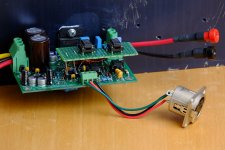 Modulus-86_R2p0_Prototype.jpg752.6 KB · Views: 637
Modulus-86_R2p0_Prototype.jpg752.6 KB · Views: 637 -
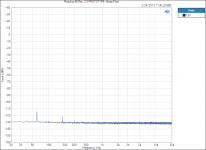 Modulus-86-Rev.-2.0-PROTOTYPE_-Noise-Floor.png45.6 KB · Views: 179
Modulus-86-Rev.-2.0-PROTOTYPE_-Noise-Floor.png45.6 KB · Views: 179 -
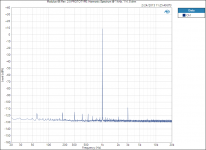 Modulus-86-Rev.-2.0-PROTOTYPE_-Harmonic-Spectrum-@-1-kHz-1-W-8-ohm.png49.1 KB · Views: 169
Modulus-86-Rev.-2.0-PROTOTYPE_-Harmonic-Spectrum-@-1-kHz-1-W-8-ohm.png49.1 KB · Views: 169 -
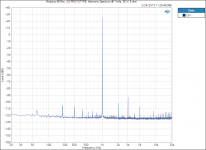 Modulus-86-Rev.-2.0-PROTOTYPE_-Harmonic-Spectrum-@-1-kHz-38-W-8-ohm.png50.8 KB · Views: 569
Modulus-86-Rev.-2.0-PROTOTYPE_-Harmonic-Spectrum-@-1-kHz-38-W-8-ohm.png50.8 KB · Views: 569 -
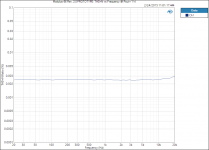 Modulus-86-Rev.-2.0-PROTOTYPE_-THD-N-vs-Frequency-@-Pout-1-W.png26.3 KB · Views: 580
Modulus-86-Rev.-2.0-PROTOTYPE_-THD-N-vs-Frequency-@-Pout-1-W.png26.3 KB · Views: 580 -
 Modulus-86-Rev.-2.0-PROTOTYPE_-THD-N-vs-Frequency-@-Pout-38-W.png27.1 KB · Views: 579
Modulus-86-Rev.-2.0-PROTOTYPE_-THD-N-vs-Frequency-@-Pout-38-W.png27.1 KB · Views: 579 -
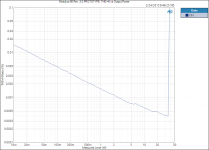 Modulus-86-Rev.-2.0-PROTOTYPE_-THD-N-vs-Output-Power.png45.6 KB · Views: 606
Modulus-86-Rev.-2.0-PROTOTYPE_-THD-N-vs-Output-Power.png45.6 KB · Views: 606
Anyway...back to what is relevant. For all builders, please read Appendix A-2 and heed the advice and warnings. You will see after a careful perusal of Tom's website that he goes to great lengths in choosing the best measuring components. They may not be the cheapest nor the most expensive, but they will be correct for the task required. This is neither the easiest board to populate nor the most difficult (although I would not advise a newbie to take such an undertaking without help). Painstaking efforts have been taken to minimize lead lengths, minimize excessive inductance, minimize supply impedances, etc...in order to maximize signal and minimize noise. Tom does this for a living, he has the chops to argue as such especially to naysayers of PCB designs. Most of those individuals have never designed one nor have they *competently* designed one.
Thank you Tom! And yippee to revision 2!
Best,
Anand.
Thank you Tom! And yippee to revision 2!
Best,
Anand.
Last edited:
Anand hits the nail on the head. I could not have said it better myself. Thank you!
Big smile!
~Tom
Big smile!
~Tom
Gosh, this is like when Tesla released the P85D without letting their previous customers know ahead of time. A lot of people were upset that they could've gotten a much better car if they had just waited.
Gosh, this is like when Tesla released the P85D without letting their previous customers know ahead of time. A lot of people were upset that they could've gotten a much better car if they had just waited.
Have you ever bought a computer? If you'd waited, you could have gotten a much better computer for the same price six months later. Of course, you wouldn't have had a computer to use the past six months, but hey... Progress happens.
The Modulus-86 Rev. 1.0 is an amplifier delivering world class performance. Its performance has not changed between yesterday and today.
Just got the shipment tracking number from the board fab. I expect to be able to ship the Rev. 2.0 boards starting around March 6th. That will allow me enough time to build up a board and verify performance.
~Tom
Last edited:
Totally agree with this view. Buying at the acceptable price performance and not regretting it. I waited a long time till I got the iPhone 6+, the earlier ones just did not meet my needs. I asked for the protruding lens so that magnetic attached lens would self centre, now I need to find good quality lens that will fit. Are there anything I wish were better? You bet! And I send recommendations in just about once a couple of weeks. There are always things you find that kind of bug you. Wish I could use two phone numbers in order to use a local SIM whenever I travel.
Don't cars get better every 4 years with a new model? Don't TVs get better with better technology? Every amp maker seeks to improve on his amp. I expect to see a Rev. 3.0 in the future. Don't get complacent. Make life better for all.
On my setup, the NS Zobel values sound slightly better than the values in the Modulus 86, if it were an AB test, I think the difference would be inaudible. But since I mod one channel at a time, the difference between the channels are more easily detected. This is one method I use for listening comparison in order to exercise the brain.😀You need the Zobel network to ensure the stability of the amplifier. See my explanation here: http://www.diyaudio.com/forums/chip...ensation-network-cc-rf2-cf-2.html#post4235244
~Tom
Why yes, but thanks for the (perhaps unintended) patronization.Have you ever bought a computer? If you'd waited, you could have gotten a much better computer for the same price six months later. Of course, you wouldn't have had a computer to use the past six months, but hey... Progress happens.
~Tom
Very rarely is there a huge step up in bang for your buck in the PC world, but even so, I was referring to the specific event of Tesla putting out a much better car for roughly the same amount of money *without* giving prior warning. I didn't falsify the fact that a lot of people got butthurt over it, and was just pointing out the similarity.
As someone who bought the V1 board I don't feel 'butthurt' at all. The comparison with Tesla is daft. The V1 already has performance that very little else can match and is below any known audibility thresholds. The enhancements are nice to have but nothing that suggests anyone could hear a difference between the 2 boards.
I'm rather pleased Tom is not resting on his Laurels and looking at ways to make things better.
I'm rather pleased Tom is not resting on his Laurels and looking at ways to make things better.
Tom,
can you explain why many PSU+amp often show odd harmonics of the mains frequency in the output, but virtually no even harmonics?
This typical characteristic shows, even though the mains ripple is at double the mains frequency, i.e. 120Hz in the USA.
Your latest confirms that even harmonics are virtually unmeasurable and yet we see tiny amounts of third, fifth, etc.
can you explain why many PSU+amp often show odd harmonics of the mains frequency in the output, but virtually no even harmonics?
This typical characteristic shows, even though the mains ripple is at double the mains frequency, i.e. 120Hz in the USA.
Your latest confirms that even harmonics are virtually unmeasurable and yet we see tiny amounts of third, fifth, etc.
Last edited:
Tom,
can you explain why many PSU+amp often show odd harmonics of the mains frequency in the output, but virtually no even harmonics?
This typical characteristic shows, even though the mains ripple is at double the mains frequency, i.e. 120Hz in the USA.
Your latest confirms that even harmonics are virtually unmeasurable and yet we see tiny amounts of third, fifth, etc.
The ripple voltage is almost a sawtooth, hence, contains all harmonics, both even and odd. I suspect the even harmonics end up canceling due to the split supply used in most amps.
~Tom
I think im gonna wait till version 10.0 comes out 😛
You will likely be in for a rather long wait... 🙂
My plan is to develop the Parallel-86. This will be an LM4780-based amp with both of the channels of the LM4780 in parallel. The Parallel-86 is ideally suited for those who need to drive low impedance speakers or want to operate at ±35 V rails for the extra output power. The Parallel-86 would also be the best candidate for bridging.
I'm about 99 % committed to using the LM4780. I may end up with two LM3886es if the board layout blows up with the LM4780. Time will tell. I do like the idea of having only one thermal interface to worry about, though.
~Tom
Last edited:
Boards are in!
The Modulus-86 Rev. 2.0 boards have arrived. I've assembled and tested one of them. See the results below.
The measurements were taken with an unregulated power supply consisting of a toroidal transformer, diode bridge, and 2x22000 uF of reservoir capacitance. The supply voltage was adjusted using a variac to provide ±28 V at the full output power (not including ripple voltage).
The boards will ship tomorrow to those who preordered. Thank you for your business!
~Tom
The Modulus-86 Rev. 2.0 boards have arrived. I've assembled and tested one of them. See the results below.
The measurements were taken with an unregulated power supply consisting of a toroidal transformer, diode bridge, and 2x22000 uF of reservoir capacitance. The supply voltage was adjusted using a variac to provide ±28 V at the full output power (not including ripple voltage).
The boards will ship tomorrow to those who preordered. Thank you for your business!
~Tom
Attachments
-
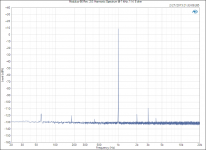 Modulus-86 Rev. 2.0_ Harmonic Spectrum @ 1 kHz, 1 W, 8 ohm.png47.8 KB · Views: 294
Modulus-86 Rev. 2.0_ Harmonic Spectrum @ 1 kHz, 1 W, 8 ohm.png47.8 KB · Views: 294 -
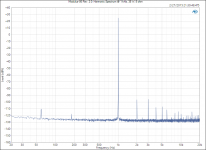 Modulus-86 Rev. 2.0_ Harmonic Spectrum @ 1 kHz, 38 W, 8 ohm.png48.9 KB · Views: 291
Modulus-86 Rev. 2.0_ Harmonic Spectrum @ 1 kHz, 38 W, 8 ohm.png48.9 KB · Views: 291 -
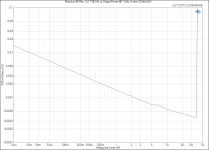 Modulus-86 Rev. 2.0_ THD+N vs Output Power @ 1 kHz, 8 ohm, 20 kHz BW.png38.5 KB · Views: 772
Modulus-86 Rev. 2.0_ THD+N vs Output Power @ 1 kHz, 8 ohm, 20 kHz BW.png38.5 KB · Views: 772 -
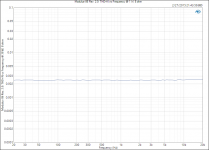 Modulus-86 Rev. 2.0_ THD+N vs Frequency @ 1 W, 8 ohm.png26 KB · Views: 784
Modulus-86 Rev. 2.0_ THD+N vs Frequency @ 1 W, 8 ohm.png26 KB · Views: 784 -
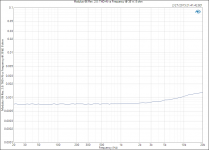 Modulus-86 Rev. 2.0_ THD+N vs Frequency @ 38 W, 8 ohm.png26.9 KB · Views: 856
Modulus-86 Rev. 2.0_ THD+N vs Frequency @ 38 W, 8 ohm.png26.9 KB · Views: 856 -
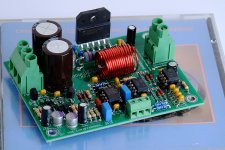 MOD86_R2p0_AssembledBoard.jpg830.5 KB · Views: 936
MOD86_R2p0_AssembledBoard.jpg830.5 KB · Views: 936 -
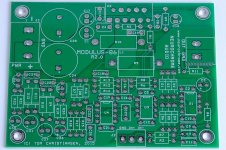 MOD86_R2p0_BareBoard.jpg169.6 KB · Views: 919
MOD86_R2p0_BareBoard.jpg169.6 KB · Views: 919 -
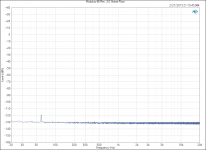 Modulus-86 Rev. 2.0_ Noise Floor.png42.9 KB · Views: 288
Modulus-86 Rev. 2.0_ Noise Floor.png42.9 KB · Views: 288
- Home
- Vendor's Bazaar
- Modulus-86: Composite amplifier achieving <0.0004 % THD+N.